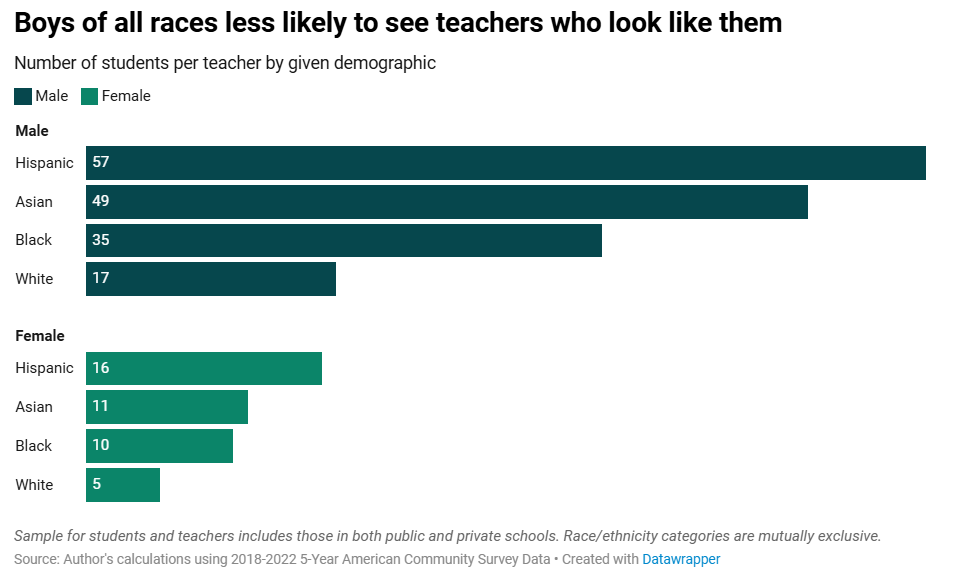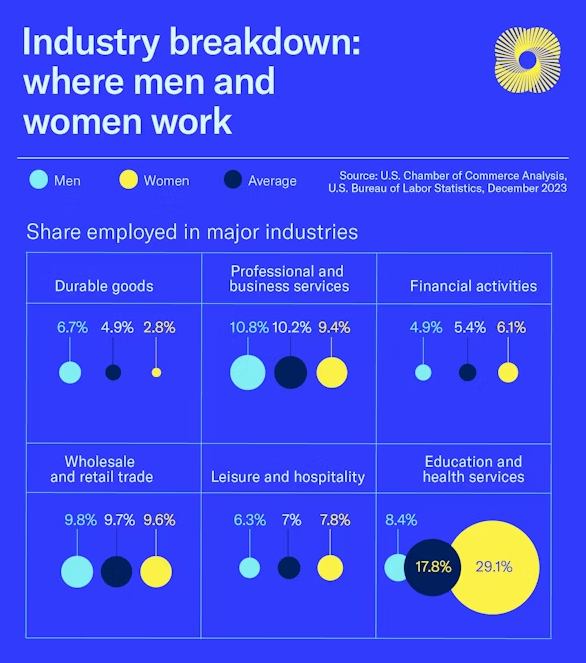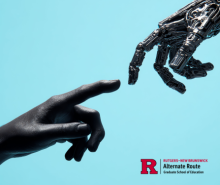Why Are Most Teachers Women?
Gender imbalances in education are a major hurdle in providing an equitable experience for students. Most (77%) teachers working in K-12 public schools are female, with that percentage increasing to 89% when only elementary grades are considered.
New Jersey’s teaching staff mirrors these national trends, with 77.2% of the state’s educators being female. This imbalance is significant considering New Jersey's student enrollment skews male, with male students accounting for 51.4% of New Jersey’s student population and female students accounting for 48.6%.

Figure courtesy of Education Next.
It’s no secret that women have dominated the teaching force for decades, even centuries. And with women outpacing men in bachelor’s degrees, the gender gap in teaching only widens. How did teaching become so feminized in the first place and what can be done to close the gender gap and enhance student learning?
How teaching became feminized

History points to how the education gender gap has existed for so long.
Interestingly, teaching used to be a male-dominated field. Before the 17th century, priests and prophets filled the role of educators. While women had important roles in the church, priests were male, meaning only men could pass on education. These instructor roles were coveted, as they served the children of wealthy families and were paid well.
This trend lasted until the 1800s. In America, there was a growing interest in education and a higher educational standard for men in general. Pursuing higher education became more widespread for men, who were more likely to have reading and writing skills. Literacy for women, on the other hand, was not a priority.
This dynamic began to evolve around 1820 when American women could access educational opportunities through teacher training academies. For women denied schooling growing up, these academies were their only access to education and, ultimately, independence.
The Industrial Revolution—also happening during this time—changed life as we know it and is responsible for much of the technology we have today. It also increased job numbers with machinery that needed manning. These new jobs came with higher salaries compared to teaching, pulling more men away from teaching. Additionally, women’s factory opportunities were limited to unskilled labor positions, keeping overall career options low for women.
Teaching was fully feminized by the 20th century due to so many women becoming teachers between 1850 and 1900. Pushing the teaching-as-women' s-work narrative was Catharine Beecher. A complicated figure, Beecher advocated for educational reform and believed women were best suited to meet children’s emotional and academic needs. She held this belief so firmly that she opposed women’s suffrage because it got in the way of teaching.
In the 1960s, women began to see more diversified career options. However, after more than a century of messaging, the ‘teaching as women’s work’ attitudes held firm.
What happens when you gender professions
Through career demographics, we’re seeing how modern times are upholding historical trends and beliefs.
Even in 2025, women still dominate care and service-based jobs, like teaching. According to U.S. Chamber of Commerce data from 2023, nearly all (97%) kindergarten and preschool teachers are women.

Research pushes back on history—including Beecher’s strongly held belief that teaching is for women. Equal gender representation in classrooms only improves student outcomes because of gender’s role in learning. For example, girls must field bias in STEM as early as kindergarten and benefit from witnessing women teach those subjects.
Likewise, male teachers benefit schools as they are often seen as mentors to students. A 2023 study highlighted the impact, focusing on the mentorship benefits male teachers bring:
“Overall, male school personnel are more likely to be identified as natural mentors (59%) and are more likely to develop cross-gender natural mentorships with female students (36% of all relationships with male mentors) compared to female personnel with male students (24% of all relationships with female mentors).”
The study also brings attention to how an unbalanced teaching population can negatively affect vulnerable populations.
“Given that the U.S. high school teacher workforce is overwhelmingly white (79%), female (59%), and from middle and upper middle class SES backgrounds (Hussar et al., 2020; Jacinto and Gershenson, 2021), we might expect students of color, students from economically disadvantaged backgrounds, and male students to be less likely to develop informal mentorships with school personnel.”
New Jersey has programs and initiatives in place to help close this gender gap.
We know men are more likely to change careers and pursue teaching, and the New Jersey Department of Education (NJDOE) has supported programs like Rutgers Alternate Route and ParaPreppED to help stimulate the new teacher pipeline. The state has also increased efforts to recruit more male teachers of color so its teaching force matches the student body.
In 2019, Gov. Phil Murphy signed S703, which established a pilot program within NJDOE to help recruit more minority men in education. That same year, Rutgers University received a $375,000 “Diversifying the Teacher Pipeline” grant from NJDOE.
Diverse teaching forces profoundly impact students because they reflect the backgrounds of the students they teach—backgrounds that are typically not at the classroom forefront. When students see themselves reflected in the classroom, they are more motivated to engage in learning.
If you’re considering following your dream of teaching, Rutgers Alternate Route can offer you the support and training you need to succeed. Be sure to follow Rutgers Alternate Route on Twitter and sign up for Alternate Route’s monthly newsletter for more information and stories from the field of education.

 Lindsay Patton is a digital communications professional who specializes in social media, writing, digital marketing, e-commerce, podcasting and other content-focused endeavors. Since 2019, she has assisted Alternate Route with its marketing strategy to help the program reach new audiences. As a result of this collaboration, Alternate Route has introduced Lindsay to many of New Jersey's talented educators, who have had a direct influence on her own classroom strategies as an adjunct professor. She is grateful for the opportunity to create meaningful content that helps increase equity within classrooms and is inspired by Alternate Route's hardworking team.
Lindsay Patton is a digital communications professional who specializes in social media, writing, digital marketing, e-commerce, podcasting and other content-focused endeavors. Since 2019, she has assisted Alternate Route with its marketing strategy to help the program reach new audiences. As a result of this collaboration, Alternate Route has introduced Lindsay to many of New Jersey's talented educators, who have had a direct influence on her own classroom strategies as an adjunct professor. She is grateful for the opportunity to create meaningful content that helps increase equity within classrooms and is inspired by Alternate Route's hardworking team. 





